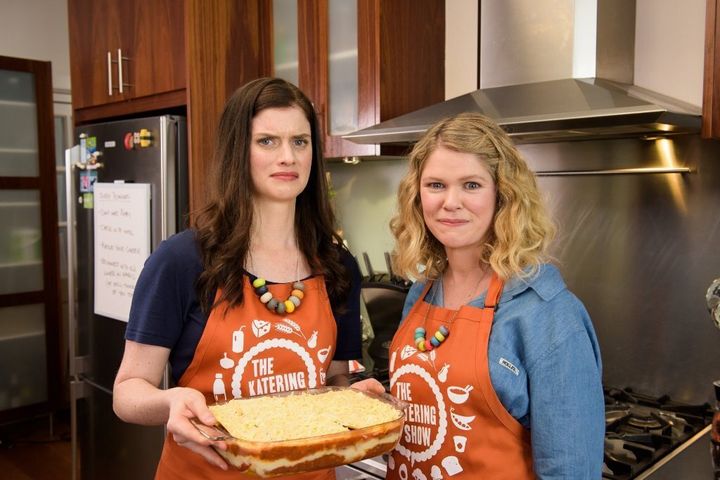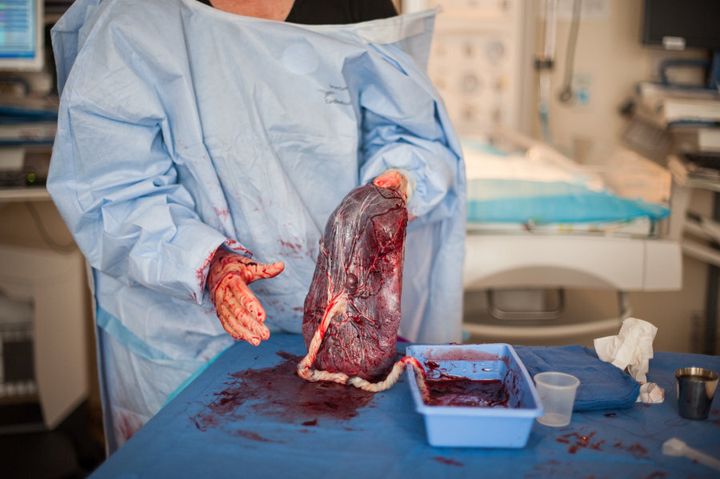
Just because Kim Kardashian has done it, it doesn't mean you should.
Firstly, someone needs to have that printed on a t-shirt. Secondly, while this statement could undoubtedly be referring to any number of Kimmy K antics, the one we are specifically addressing today is the 35-year-old's decision to encapsulate (and then consume) the placenta from both of her births.
And she's not alone. Many mothers around the world are making the decision to eat their placentas (either raw, cooked or in capsule form) due to a range of purported health benefits which include hormonal regulation, lowered risk of postpartum depression and increased breast milk production.
But is there any proof in this placenta pudding? The Huffington Post Australia spoke to Winthrop Research Professor Jeffrey Keelan from the School of Women's and Infants' Health to find out.
Why do women eat their placentas?
Aside from wanting to be like the bevy of celebrities who have publicly endorsed placentophagy (January Jones, Kim and Kourtney K, Alicia Silverstone, we're looking at you) there are numerous arguments made as to why humans should consume their placentas after birth.
"One of the claims often made is that all mammals eat their placentas," Keelan told The Huffington Post Australia.
"Humans and camels are apparently the only the two species who don't this regularly. People who promote it say it's a natural process people should be doing, just like [placental mammals] do."
The other, more popular argument centers more around potential health benefits, including keeping postpartum depression at bay.
"It has been said to be a way of restoring hormones and nutrients and vitamins from the placenta back into the body, in order to correct deficiencies that may have arisen throughout the pregnancy and labour process," Keelan said.
How is it eaten?
There are three basic ways you can choose to consume your placenta: by eating it raw, cooked, or having it made into tablets.
Encapsulation -- which sees the placenta steamed, dehydrated, ground, and put into pills -- is currently the most popular form of ingestion and, in Australia, can be offered as a service from a midwife or other trained professional.
"People now taking taking courses to learn how to encapsulate placentas, and it's becoming increasingly popular," Keelan said. "There are probably quite a few people around now who can make these placenta capsules. It's rapidly becoming a service people can use."

Does it work?
"There is actually no evidence at all from any proper scientific trial that it actually has any benefits," Keelan said.
"Having said that, there are plenty of anecdotal stories about women who have had bad experiences in past pregnancies, but with their next pregnancy decided to take capsules and have said, as a result, they felt almost immediately better.
"There are anecdotal reports of women feeling less stressed, more able to cope, finding that breast feeding is easier, producing more breast milk, and basically feeling dramatically transformed.
"In saying that, it could all be a placebo effect. We don't know for sure."
As for Keelan's professional opinion, he thinks the likelihood of these purported benefits being due to placentophagy is unlikely, to say the least.
"I'm a skeptic. There are a number of reasons I think it's bogus," Keelan told HuffPost Australia.
"Firstly, the major benefits are supposed to be preventing postnatal depression, improving milk production and breast feeding, improving general mood and, apparently, reducing pain after childbirth.
"But it would take a significant dosage of estrogens and progesterones to have that effect, and it's been studied that the levels of hormones in placenta pills are greatly reduced. By the time it goes through the process there wasn't much [hormone] left.
"Theoretically you could be getting some of these hormones, but whether that's enough taken orally -- and they are not very well absorbed orally anyway -- but if it's enough to take your blood levels back to where it was before you were pregnant, and to give you relief from the sudden withdrawal of steroids that occurs after childbirth, I very much doubt."

Keelan also stated, not only was it was "very, very unlikely any of those [peptide hormones] survived the processing involved," but they would "certainly would not survive processing through the stomach and the stomach acid.
"From a personal view, it's very unlikely a significant dose of anything that would be likely to improve your mood would survive these processes. It's a theoretical possibility, but it's very unlikely."
Potential risks
According to Keelan, there are two main ways in which consuming your placenta can prove to be risky: by infection, and from the possibility of ingesting toxins.
"Regarding infection, if you think about the placenta, is has been passed through the vagina and could have potentially picked up bacteria along the way," Keelan said.
"There is certainly the risk of unintended infection from contamination of outside materials.
"One video I saw suggested you store it in a newspaper, which is obviously not advisable. There are toxins in the ink and the newspaper itself is certainly not sterile. I would say there is definitely a chance of infection via the process of storage or the way it's delivered."
There is also the argument that the placenta can store harmful toxins as a way of protecting the baby from exposure to certain things and as such, the mother then choosing to ingest it could prove harmful.
It's a risky thing, and it's based on anecdotal evidence from other mothers. It isn't tested. There are no real studies to show it's beneficial.
"The placenta stores a lot of stuff as part of its role to protect the baby, and it is possible that it stores potential toxins in the tissue. When it's delivered, it has actually accumulated nine months of all sorts of things," Keelan said.
"For instance, there is evidence to suggest if the mother is a smoker, the placenta will show levels of cadmium storage. Now cadmium is a pretty nasty heavy metal and not something you want to be exposed to. The placenta seems to store it up so that the baby is not exposed to it.
"Theoretically, if you ingest the placenta, you could also be ingesting these stored-up toxins, though the levels recorded in studies to appear to be pretty low and below the maximum allowable intake as stated by regulatory authorities."
In conclusion
"All in all, the benefits are theoretical and claimed by the proponents as a result of anecdotal evidence only. At this stage there is no solid scientific evidence to back them up," Keelan said.
"The risks are potentially significant but also probably unlikely. Then again, while the risks are pretty low, you might be the one in 200 or something who has a big chunk of cadmium [in their placenta].
"It's a risky thing, and it's based on anecdotal evidence from other mothers. It isn't tested. There are no real studies to show it's beneficial.
"In my opinion it's a lot of trouble to go through for some risks and no real benefits."
